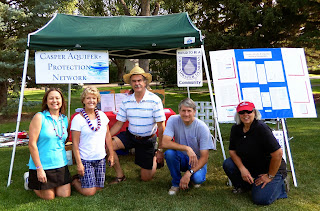by Karen Griffin, Vice President, Olsson Associates
It is 6:30 a.m. and today I’m
off to Riverton, Wyoming, to attend the annual conference for Conservation
Districts. This is the first time I’ve been to this conference, and I’m excited
to see some of the clients we’ve been working with and return to the only state
in the country with a cowboy on its license plate. My mention of the cowboy will
become abundantly clear as I describe one day on a recent trip to Wyoming. It
was one of the most memorable days I’ve ever had as a consulting geologist.
For the past year and a half,
we have been working on a watershed study for the Wyoming Water Development
Commission (WWDC) and the Teton Conservation District (TCD) in Jackson,
Wyoming. Yes, the study area includes the Grand Tetons, Bridger-Teton National
Forest, portions of Yellowstone National Park and the entire National Elk
Refuge. The watershed is 1.7 million acres of land in the center of the Greater
Yellowstone Ecosystem, the largest intact ecosystem in the lower 48 – not to
mention it includes one of the country’s most iconic mountain ranges. One that
takes your breath away each and every time you see it.
 |
| The Grand Tetons at Grand Teton National Park |
As I’ve headed out west to
complete the project, I’ve had a lot of volunteers who wanted to join the
project team. Who wouldn’t want to go to Jackson Hole every two months to see
the seasons change across the amazing landscape?! And, luckily for us all, the
scope of the project is almost as vast as the landscape and so I have been able
to bring out several of our best scientists and engineers to help complete the
project.
 |
The team
visiting Jenny Lake after meeting with the National Park Service at Grand Teton
National Park. From left to right, Joan Darling, PhD (our wetlands and
permitting expert), me, Jodee Pring (River Basin Planning Supervisor for the
WWDC), and Brian Degen, PE (our irrigation engineer).
|
We were hired by the WWDC and
the TCD to complete a Level I watershed study. A Level I watershed study
is holistic evaluation of an area that is interconnected by water. The study
evaluates the current condition of an area and looks at opportunities for water
improvement projects that will restore, maintain, and enhance healthy watershed
function. Specifically, a Level I watershed study looks for projects, programs,
or activities that support sustainable, beneficial water use for current and
future watershed residents – be they human, animal, or plant.
To learn the issues facing the
water users in the district, we held public meetings in the town of Jackson and
in the small community of Moran near the south entrance to Yellowstone. At the
meetings, we heard from ranchers, land managers, wildlife conservationists, and
the urban and rural residents about their issues with both drought and
flooding. The summer of 2016 was no exception with dry conditions causing three
major fires in the watershed. You may have heard about the Berry Fire that was
reported on the national news because it closed the southern entrance to
Yellowstone for several weeks. Conversely, in the winter, ice jams form in Flat
Creek and they block the water flow through Jackson causing winter flooding in
the residential and commercial parts of town. Water issues not only affect
tourism and the urban residents; we heard from many of the local ranchers about
the need to upgrade the irrigation systems that supply water to the green
pastures that feed both livestock and wildlife across the watershed.
The greatest thing about these
Level I watershed studies is that we start the project by completing a
description and inventory of the watershed.
At the same time, we hold public meetings and go out to see the issues
first hand. So the project team gets to see the big picture of the watershed as
a whole by developing a series of GIS maps that document, for example, the
geology, soils, land use, wetlands and sensitive habitats. And we also get to
go see “the boulder that destroyed the headgate on our irrigation canal.” We
then put together conceptual plans and cost estimates for the water improvements
identified by the residents and stewards of the land.
 |
Here is a prime
example of the irrigation system improvement needs in the Upper Snake River
Watershed. The Jensen Creek diversion used to provide water to several ranches
just south of the Teton Village ski resort. The irrigation structure was crushed by a gigantic boulder during a
debris flow. We prepared a conceptual plan and cost estimate for a replacement
structure downstream this site.
|
That gigantic boulder was a
pretty amazing thing to see, but the day I wanted to tell you about started at
a public meeting at Fire Station #4 in Moran. We held a public meeting to find
out what types of water improvement projects were needed in the northern part
of the watershed. Several local ranchers came to hear what the study was about
and realized that the issues they had with deteriorating and inefficient
irrigation systems may be eligible for funding through the WWDC Small Water
Project Program. Mort Yoakum, manager of the historic Pinto Ranch, invited me
to come visit the ranch the next day. Before he left he asked me one question:
“Do you know how to ride a horse?”
I met him at the ranch
headquarters the next morning where we loaded up two horses to ride across the
pastures that needed irrigation system improvements. As we rode across the
ranch, Mort told me the story of how the ranch was homesteaded and how at one
time ran 2,000 head of cattle across this area. He showed me the flood
irrigation ditches that crisscross the landscape. Some ditches were dug over
100 years ago, and we talked about some options that could be proposed to help
improve water delivery, while improving water conservation. I asked him why he
didn’t use ATVs to get around the ranch like so many ranchers do these days. He
explained the ditches were too wide and deep in places for the ATVs to cross
but the horses can jump across them easily. Next thing you know, he led us
across a ditch and, yes, my horse easily leapt across without hesitating!
 |
Mort Yoakum,
manager of the Pinto Ranch takes me across their allotment on the Elk Ranch
located in the northeast corner of Grand Teton National Park. The Tetons were
covered in a haze that day because the Berry Fire was burning at the entrance
to Yellowstone.
|
With that, I’ll leave you with
my favorite picture of Mort, pointing to the main irrigation ditch as he
described where he needed the water to feed his cattle, the antelope, and the
heard of over 800 wild buffalo that share the natural resources of this area.
 |
Sunrise on the
Elk Ranch at Grand Teton National Park discussing more efficient ways to
deliver water to the cattle and wildlife that depend on this most precious
resource. Yep, those are my horse’s ears in the foreground; we had a fantastic
ride that morning.
|
Some days I wonder how I could be so lucky to have a job where I get to try to help folks find ways to conserve and protect this most precise resource – the interconnected groundwater and surface water that define this watershed. Especially when it means taking a ride across this iconic landscape with a rancher who is trying to maintain the legacy of a historic ranch while at the same time, preserving the natural resources that nourish a part of the greater Yellowstone Ecosystem.
____________________
About the Author
Karen Griffin is a professional geologist managing multidisciplinary projects focused in the fields of geology and hydrogeology. She began her career in environmental geology in Santa Barbara, CA and moved to Boulder, CO to take a position as project manager for the restoration and cleanup of a 27 square mile superfund site called the Rocky Mountain Arsenal National Wildlife Refuge. She moved back to her home town in 2004 and is currently a Vice President and the Groundwater Technical Leader for Olsson Associates in Lincoln, Nebraska. Reach her at kgriffin@olssonassociates.com.
 4. The Hydrogeology Challenge event created for Science OIympiad (SO) was featured in the 2016 National Tournament. The Challenge has been adapted for use in classrooms and extracurricular activities beyond SO.
4. The Hydrogeology Challenge event created for Science OIympiad (SO) was featured in the 2016 National Tournament. The Challenge has been adapted for use in classrooms and extracurricular activities beyond SO.






























